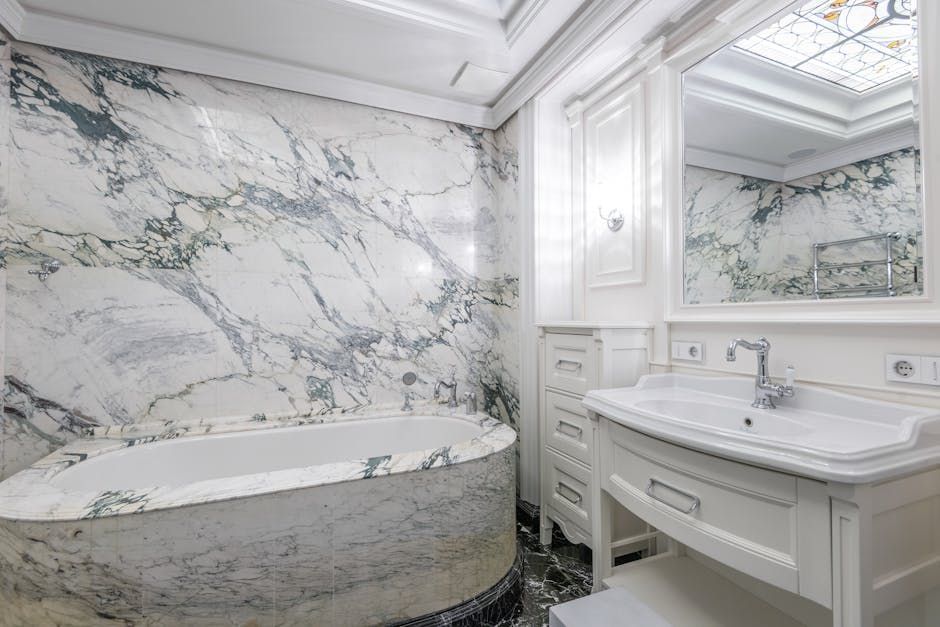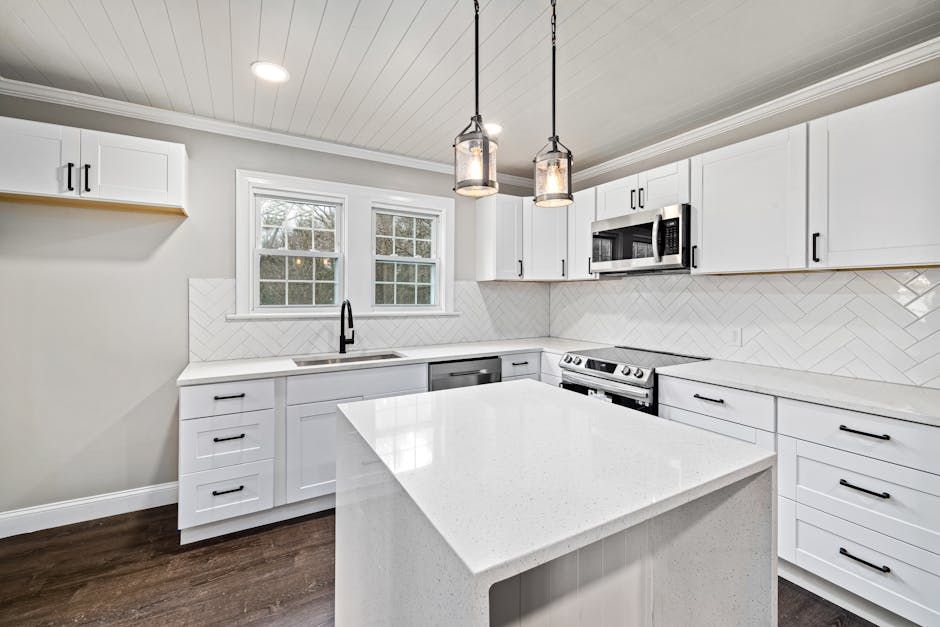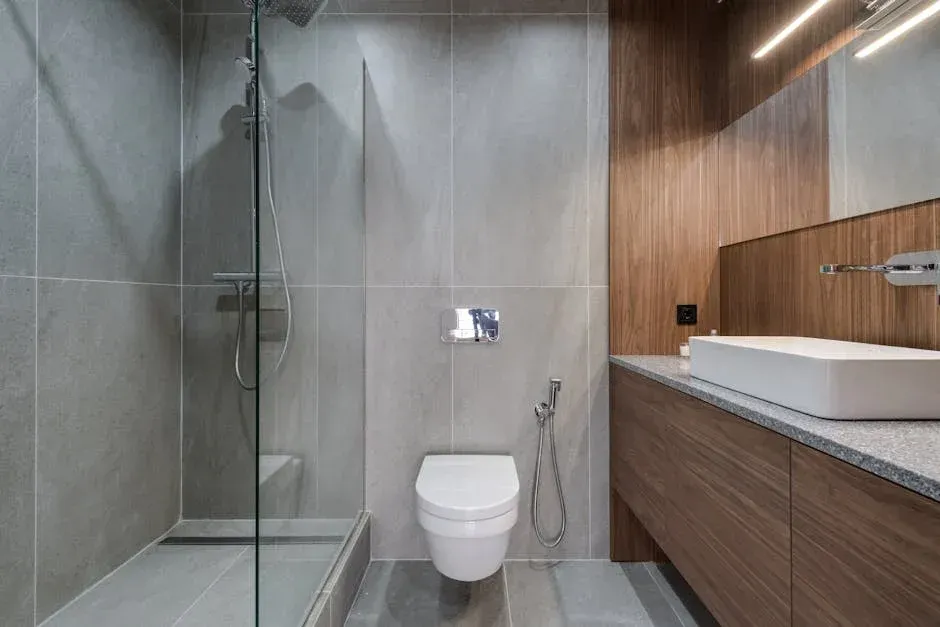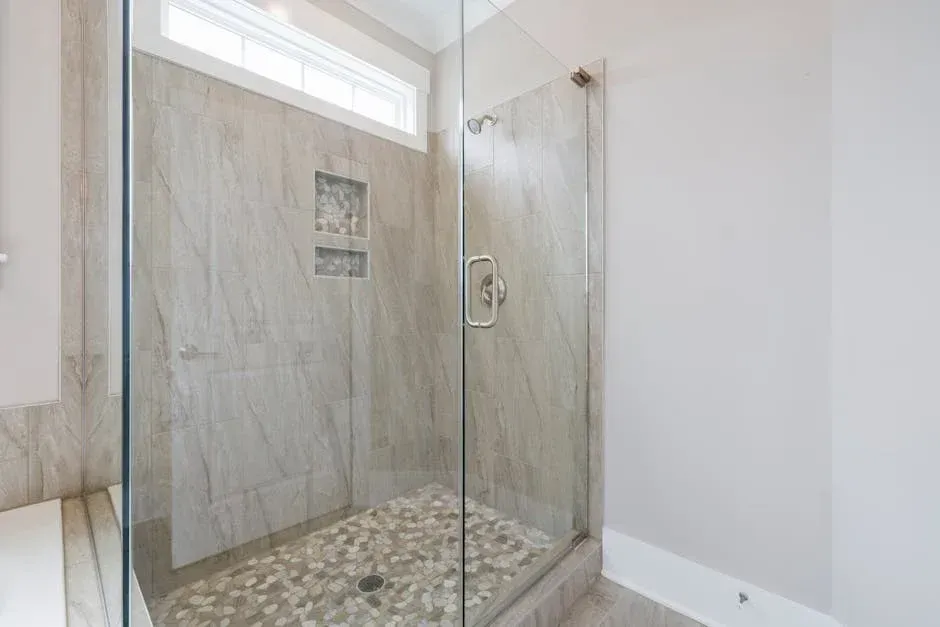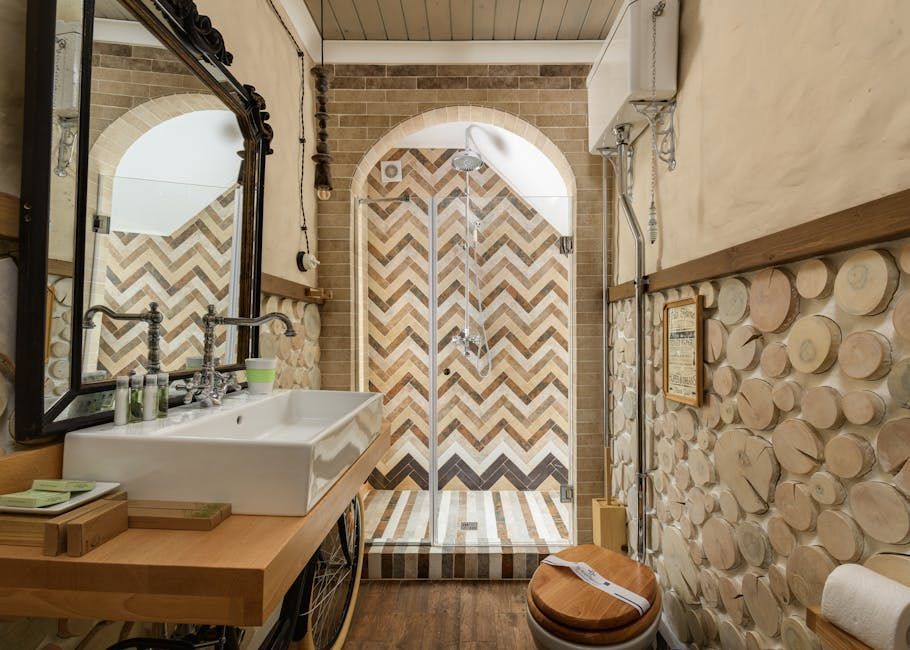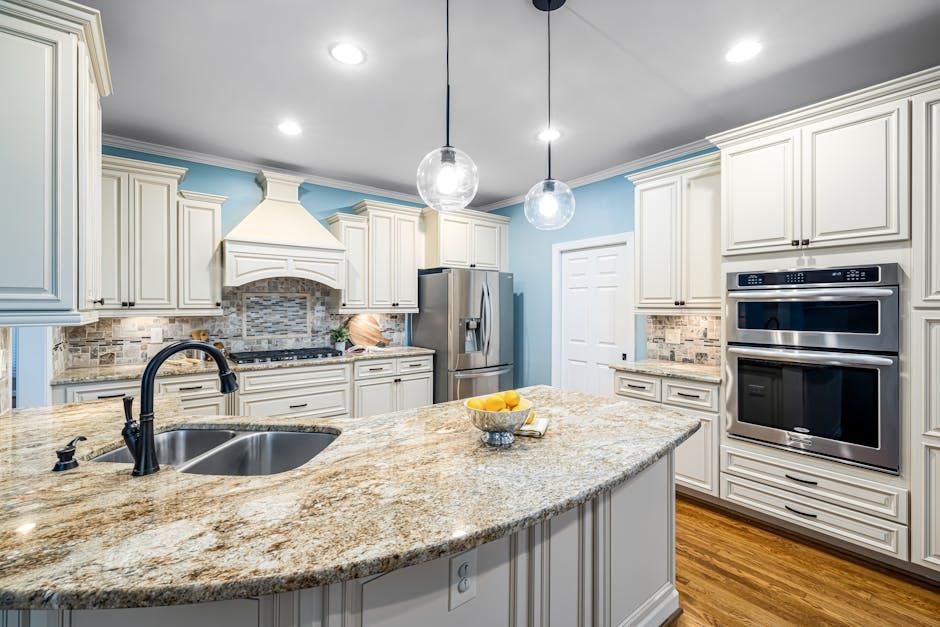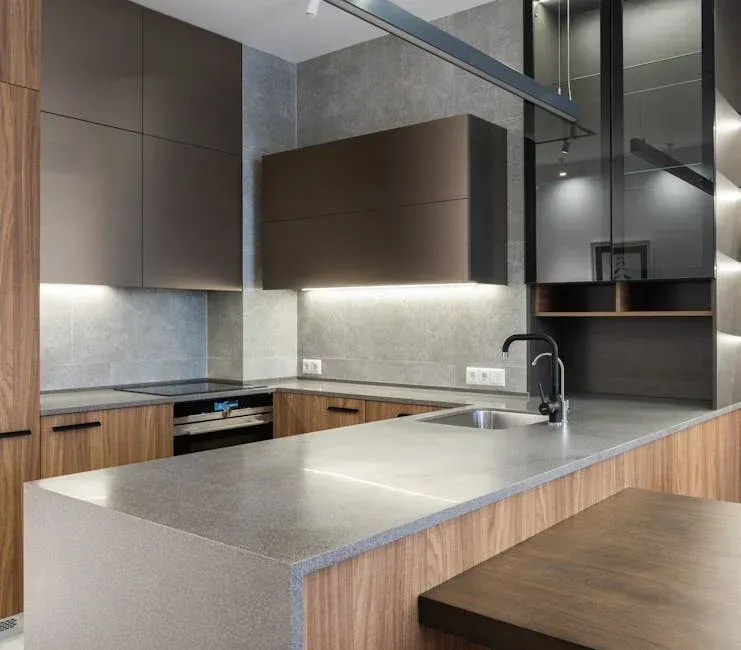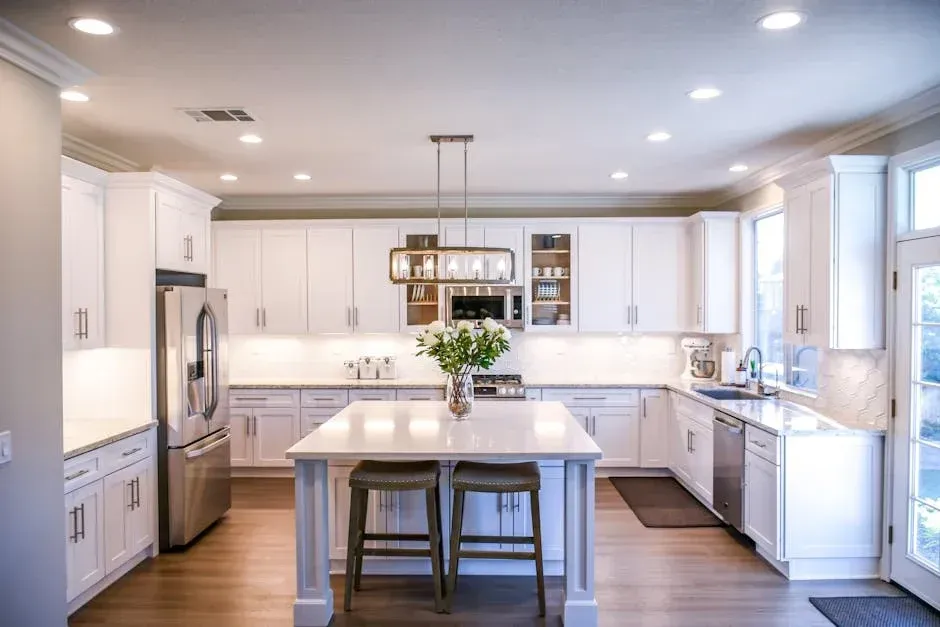Kitchen Confidential: Sustainable Design Tips for the Heart of Your Home
Creating Earth-Friendly Kitchens: A Sustainable Vision
Sustainable kitchen designs combine eco-friendly materials, energy-efficient appliances, and thoughtful layouts to create beautiful spaces that minimize environmental impact. If you're looking to create a more sustainable kitchen, here are the key elements to consider:
- Eco-friendly materials: FSC-certified wood, bamboo, recycled glass, cork flooring
- Energy-efficient appliances: ENERGY STAR certified, induction cooktops (300% more efficient than gas)
- Water conservation: Low-flow faucets that reduce water usage by 30%
- Healthy indoor air: Low or zero-VOC paints and finishes
- Waste reduction: Built-in recycling and composting systems
The kitchen isn't just the heart of your home—it's also where some of your largest environmental decisions are made. From the energy your appliances consume to the materials in your cabinetry, every choice matters. More than half of real estate professionals report their clients are increasingly interested in sustainability, and for good reason.
Creating a sustainable kitchen isn't just about being environmentally responsible—it's about designing a healthier space for your family while potentially saving money. Energy Star-certified appliances can save a typical household $450 on their energy bills each year, while smart design choices can significantly reduce your carbon footprint.
I'm Mike Martinez from Accountable Home Remodeling, and I've helped countless Denver homeowners transform their kitchens with sustainable kitchen designs that balance beauty, functionality, and environmental responsibility. My team focuses on integrating eco-conscious elements that suit your style and budget while creating spaces that last for generations.

Why Sustainable Kitchen Designs Matter
The kitchen truly is the heart of your home, but it's also potentially the most resource-hungry room in your house. From energy-guzzling appliances to excessive water usage and material waste, traditional kitchens can leave a surprisingly large environmental footprint. By embracing sustainable kitchen designs, you're making a choice that benefits both your family and our planet for generations to come.
"The first priority of a renovation or new build should be the sustainability and long-term use of the kitchen," notes a real estate professional with over 20 years of experience. This sentiment is increasingly shared by homeowners across the Denver Metro Area, from Boulder to Aurora, as environmental consciousness continues to grow.
When we design sustainable kitchens at Accountable Home Remodeling, we're thinking beyond just creating a beautiful space. We're considering how your kitchen will function efficiently for decades, how it will contribute to your family's health and wellbeing, and how it will tread lightly on our natural resources.
The Environmental Impact of Traditional Kitchens
Traditional kitchens can be surprising environmental offenders in ways many homeowners don't realize. Your conventional refrigerator and dishwasher alone can account for at least 10% of your home's total energy consumption. Those standard kitchen faucets? They're typically pumping out 2.5 gallons of water per minute – much of it wasted.
What about the air you breathe while cooking for your family? According to the EPA, indoor air may be two to five times more polluted than outdoor air, with kitchens contributing significantly through off-gassing from cabinetry, countertops, and flooring made with toxic materials. Those beautiful conventional cabinets might be releasing formaldehyde into your home for up to two years after installation.
The manufacturing, transportation, and eventual disposal of kitchen materials create substantial carbon emissions and landfill waste too. It's a lot to consider, but as Stephanie Horowitz, an architect and sustainability expert, puts it: "People expect green design — or should expect it." We couldn't agree more.
Economic Benefits of Going Green
While the initial investment in a sustainable kitchen may be higher (typically 10-50% more than conventional remodels), the long-term financial benefits make it well worth considering:
Your utility bills will shrink noticeably when you install ENERGY STAR certified appliances, which use significantly less electricity and water – saving approximately $450 annually for the average household. Modern induction cooktops are particularly impressive, operating at up to three times more efficiently than gas.
Your home value will likely increase too. Eco-friendly kitchens are increasingly attractive to today's environmentally conscious buyers. The sustainable materials we use are typically more durable and require less frequent replacement, meaning lower maintenance costs over time. Depending on your location, you might even qualify for rebates or tax breaks for energy-efficient upgrades.
There's also the health factor – improved indoor air quality from using low-VOC materials and proper ventilation can reduce allergy symptoms and other health issues associated with toxic materials. Your family breathes easier, literally.
As one of our Westminster clients recently told us, "Our sustainable kitchen remodel has paid for itself in energy savings and increased home value. Plus, we feel good knowing we've made choices that benefit the environment."
When you choose energy-efficient lighting solutions and other green features for your kitchen, you're making an investment that pays dividends in multiple ways – for your wallet, your health, and our shared environment. That's the kind of smart, forward-thinking approach we love to help our clients achieve.
Sustainable Materials for Your Kitchen Renovation
Choosing the right materials for your kitchen renovation isn't just about aesthetics—it's about making choices that will benefit both your home and our planet. Here at Accountable Home Remodeling, we've guided countless Denver families through the sometimes overwhelming world of sustainable materials, helping them create kitchens that are as beautiful as they are environmentally responsible.
As I like to tell my clients, "Your kitchen tells a story. Why not make it one that future generations will thank you for?" Let's explore the materials that can make your kitchen renovation both stunning and sustainable.
Eco-Friendly Cabinetry Options
Cabinetry dominates your kitchen's visual space and represent a significant portion of your renovation's environmental impact. The good news? You don't have to sacrifice style for sustainability.
FSC-Certified Wood cabinets carry the Forest Stewardship Council's seal of approval, which means the wood comes from responsibly managed forests. I recently worked with a Lakewood family who chose cherry cabinets with this certification, knowing their beautiful kitchen wouldn't come at the expense of forest ecosystems or indigenous communities.
Reclaimed Timber brings history and character into your kitchen while giving new life to old wood. One of my favorite projects involved changing timber from a 100-year-old Denver warehouse into stunning kitchen cabinets. Every knot and grain pattern tells a story, and the wood's quality is often superior to newly harvested timber—those old-growth forests produced wood with tighter grain patterns that you simply can't find today.
Bamboo Alternatives have become increasingly popular, and for good reason. Unlike traditional hardwoods that can take decades to mature, bamboo reaches harvest age in just 3-5 years. It's naturally pest-resistant (goodbye, pesticides!) and incredibly durable. Just be sure to ask about sourcing—bamboo that travels halfway around the world might not be as eco-friendly as locally sourced options.
When it comes to cabinet construction, what you don't see matters just as much as what you do. Non-Toxic Construction means cabinets built with formaldehyde-free adhesives and finished with low or zero-VOC products. Your family will breathe easier—literally—with cabinets that don't off-gas harmful chemicals into your home for years after installation.
As one of our clients in Highlands Ranch put it, "We spend so much time in our kitchen. Knowing our cabinets aren't slowly polluting our indoor air gives us peace of mind we never even knew we needed."
Sustainable Countertop Materials
Your countertops are both workhorses and showpieces—and they can also be champions of sustainability.
Recycled Glass countertops transform bottles and windows destined for landfills into stunning, durable surfaces. Each one is unique, with glass pieces creating a terrazzo-like appearance in various colors. A family in Golden chose a countertop containing glass from local breweries—a conversation piece that connects their kitchen to their community's history.
Recycled Paper Composite countertops sound fragile but are anything but. Made from post-consumer recycled paper and non-petroleum resins, these surfaces are heat-resistant, incredibly durable, and available in a rainbow of colors. They're also fully renewable and biodegradable when their useful life (often decades) finally ends.
Engineered Quartz with Recycled Content offers the durability and low maintenance of traditional quartz with added environmental benefits. Brands like Caesarstone now incorporate recycled materials into their manufacturing process, reducing the need for raw material extraction while maintaining the performance qualities that make quartz so popular.
There's something undeniably warm and inviting about Reclaimed Wood countertops. Besides their obvious beauty, they give old timber new purpose. One of my favorite projects involved helping an Arvada family incorporate a century-old maple tree from their property into their kitchen island. Every meal preparation becomes a connection to their land's history—sustainability doesn't get more meaningful than that.
Environmentally Friendly Flooring Choices
Kitchen floors take a beating from foot traffic, dropped utensils, and occasional spills. Fortunately, some of the most durable options are also the most eco-friendly.
Cork Flooring might be nature's perfect kitchen floor material. Harvested from cork oak bark without harming the tree (which continues to grow and sequester carbon), cork floors offer natural resilience that's comfortable underfoot. They're naturally antimicrobial and provide thermal and acoustic insulation. Standing at the stove making Sunday breakfast becomes noticeably more comfortable on cork's slightly springy surface.
Sustainable Bamboo flooring brings the same rapid-renewal benefits to your floor that it does to cabinetry. Some varieties actually score higher on hardness tests than traditional hardwoods like oak or maple. I recently installed strand-woven bamboo floors for a family in Littleton, and they've withstood everything from dropped cast iron pans to energetic dogs without a scratch.
Natural Linoleum is the original resilient flooring—not to be confused with vinyl. Made from linseed oil, cork dust, wood flour, tree resins, and natural pigments, true linoleum is naturally antibacterial and biodegradable. With proper care, it can last 25-40 years while maintaining its beautiful appearance. The subtle, matte finish adds a sophisticated touch to both modern and traditional kitchens.
When renovating a historic home in Boulder last year, we uncovered original oak floors under layers of linoleum and carpeting. Rather than replacing them, we Reclaimed the Hardwood, refinishing it with zero-VOC products. The patina that only comes from a century of use gives the floor best character while honoring the home's history. As I like to tell clients, "The greenest material is often the one you already have."
At Accountable Home Remodeling, we believe sustainable materials should never feel like a compromise. Today's eco-friendly options often outperform their conventional counterparts while adding distinctive beauty to your kitchen. Whether you're planning a complete renovation or targeted upgrades, choosing sustainable kitchen designs means creating a space that's healthier for your family, lighter on the planet, and often more beautiful because of—not despite—these choices.
Energy-Efficient Appliances and Fixtures
The kitchen might be the heart of your home, but it's also an energy powerhouse – and not always in a good way. Your appliances and fixtures can either drain your wallet and the planet's resources, or they can work efficiently to create a truly sustainable kitchen design. At Accountable Home Remodeling, we've helped countless Denver families transform their kitchens into models of energy efficiency without sacrificing style or functionality.
Choosing Energy-Saving Appliances
Let's face it – that shiny new refrigerator isn't just about keeping your leftovers cold. It's making a statement about your values and, more practically, affecting your monthly energy bills for years to come.
ENERGY STAR certification should be your first filter when shopping for kitchen appliances. This isn't just a pretty label – it means real savings and reduced environmental impact. According to EPA data, "Energy Star-certified appliances can save a typical household $450 on their energy bills each year." When you consider that appliances typically last 10-15 years, we're talking about thousands in savings over their lifetime.
I remember working with a family in Lakewood who initially balked at spending an extra $300 on an ENERGY STAR refrigerator. Six months later, they called just to tell me how pleased they were with their lower utility bills. Sometimes the smartest investments take a little patience to appreciate.
Induction cooking technology has been a game-changer for our environmentally conscious clients. These cooktops are not only 300% more efficient than gas (and that's not a typo!), but they also eliminate indoor air pollution from gas combustion. One of my favorite client stories comes from Longmont, where a dedicated home chef was deeply skeptical about giving up her gas range. After using her new induction cooktop for just a week, she called me raving about the precise temperature control, faster cooking times, and how much cooler her kitchen stayed during summer meal prep.
When it comes to appliances, bigger isn't always better. We often work with clients to right-size their appliances based on their actual needs rather than what looks impressive. That 72-inch built-in refrigerator might make a statement, but at $18,000 and significantly higher energy consumption, is it really the smart choice for your family of three? Sometimes, thoughtfully designed smaller appliances or specialized solutions (like refrigerator drawers for frequently accessed items) can reduce energy use while actually improving functionality.
The rise of smart features in kitchen appliances offers exciting possibilities for energy conservation. Imagine refrigerators that alert you when doors are left open, dishwashers that sense exactly how dirty your dishes are and adjust water usage accordingly, or ovens you can preheat remotely just as you're heading home. These technologies help eliminate waste by using resources only when and how they're needed.
Water Conservation in the Kitchen
Water might seem abundant, but conserving it is essential for both environmental sustainability and your wallet. The kitchen is typically the second-thirstiest room in your home, after the bathroom.
Low-flow faucets have come a long way from the disappointing trickles of early models. Today's efficient fixtures can reduce water flow from the standard 2.5 gallons per minute to 1.5 gallons or less – that's a 40% reduction – while maintaining the pressure you need for filling pots or cleaning produce. For families who cook regularly, this can save thousands of gallons annually.
If you're not ready for a full faucet replacement, faucet aerators offer an incredibly cost-effective solution. These small devices cost just a few dollars but can reduce your water usage by up to 50%. They work by mixing air with water, maintaining pressure while using less of our precious resource.
Modern water-efficient dishwashers are marvels of conservation. Would you believe a good ENERGY STAR dishwasher uses as little as 3 gallons per cycle? Compare that to the 27 gallons typically used when hand-washing the same number of dishes! Plus, soil sensors ensure the machine uses only the water needed for each specific load.
I love recommending instant hot water solutions to my Denver clients. These under-sink units eliminate that wasteful habit of running water while waiting for it to warm up. As one industry expert notes, "Adding insta-hots directly under the water fixture in the kitchen can speed up the time it takes to heat water and reduce the wasted amount of water significantly." Plus, they're incredibly convenient for making tea, instant oatmeal, or sanitizing cutting boards.
Water filtration systems deliver a double sustainability win by providing clean drinking water without the environmental impact of bottled water. The plastic waste and transportation emissions associated with bottled water make home filtration an environmental no-brainer. We recently installed an under-sink system with a dedicated drinking water faucet for a family in Thornton, and they were amazed by both the improved taste and the reduction in their recycling bin.
Lighting Solutions for Sustainable Kitchen Designs
Kitchen lighting isn't just functional – it creates atmosphere, affects how food looks, and significantly impacts your energy usage. Thoughtful lighting design is essential to any sustainable kitchen design.
LED fixtures have transformed what's possible in kitchen lighting. Using up to 90% less energy than traditional incandescent bulbs while lasting up to 25 times longer, LEDs are the clear sustainability choice. They've also improved dramatically in light quality, with options ranging from warm amber tones that create a cozy atmosphere to bright daylight hues that make food prep safer and more precise.
A pro tip from our design team: when planning LED lighting, include about 10-15% more fixtures than you would with traditional lighting to achieve comparable brightness. LEDs are directional by nature, so this slight increase ensures even illumination throughout your space.
The most effective kitchen lighting incorporates a layered lighting approach with different types working together. Task lighting illuminates work areas where you need to see clearly (think under-cabinet LEDs that eliminate shadows on countertops). Ambient lighting provides general illumination throughout the space. Accent lighting highlights design features or creates atmosphere. When these layers work together with individual controls, you use exactly the light you need, where you need it.
Motion sensors and dimmers take energy efficiency to the next level. How many times have you left kitchen lights on when you've moved to another room? Motion sensors solve this common energy drain. Dimmers allow you to use only the light level needed for different activities – bright light for cooking, softer light for dining. One Boulder client told me their smart lighting system reduced their kitchen lighting energy use by nearly 60%.
The most sustainable light source comes free of charge: natural light. Whenever possible, we design kitchens to maximize daylight through strategically placed windows, skylights, or solar tubes. For a recent Denver project, we installed a tubular daylighting device that channels sunlight from the roof into what was previously a dark corner of the kitchen. The homeowners now enjoy free, natural illumination during daylight hours and report a noticeable mood boost from the additional sunlight.
I love designer Lisa K. Tharp's advice to "get creative with lighting, and try something reclaimed or retrofit — from antique library sconces to factory and ship lights, or even upside-down baskets." This approach combines sustainability with unique design elements that tell a story and create character in your space.
At Accountable Home Remodeling, we believe efficient appliances and fixtures are the workhorses of sustainable kitchen designs. They quietly save energy, water, and money day after day, year after year, while enhancing your enjoyment of the most important room in your home.
Smart Layout and Design Strategies
A truly sustainable kitchen design goes beyond materials and appliances to consider how the space functions. When we design kitchens at Accountable Home Remodeling, we think about the entire ecosystem of your space—how air flows, where light enters, and how you move through the kitchen. These thoughtful layout and design strategies not only reduce resource use but create a more enjoyable cooking environment that feels natural and intuitive.
Maximizing Natural Light and Ventilation
Natural light and proper air circulation aren't just good for the planet—they're essential for creating a kitchen that feels vibrant and healthy.
The right windows can transform your kitchen experience. South-facing windows provide abundant daylight in our Colorado climate, while properly sized overhangs prevent summer overheating without sacrificing winter warmth. For kitchens with limited exterior walls, high windows or clerestories bring light deep into the space without sacrificing valuable wall space for cabinets.
According to ENERGY STAR data, "Replacing old windows with ENERGY STAR certified windows lowers household energy bills by an average of 12 percent nationwide." This makes window upgrades a smart investment that pays dividends in both comfort and reduced energy costs.
For interior kitchens where traditional windows aren't possible, skylights and tubular daylighting devices work wonders. I recently installed a light tube for a family in Highlands Ranch whose kitchen was previously so dark they needed artificial lighting even at noon. Now, natural sunlight pours in through a discrete ceiling fixture, completely changing the space without adding to their electric bill.
Proper ventilation is equally important, especially in today's energy-efficient homes with tight building envelopes. An effective range hood vented to the exterior (not a recirculating model) removes cooking odors, moisture, and indoor air pollutants that can affect your family's health. We typically recommend quiet, low-sone models that won't discourage you from using them when cooking.
Creating cross-ventilation through strategically placed windows can reduce your need for mechanical cooling. In a recent Arvada project, we positioned windows to create a natural draft that pulls fresh air through the kitchen and pushes warm air out. The homeowners were amazed at how comfortable their kitchen remained even during Colorado's hot summer days.
Waste Management Solutions
One of the most overlooked aspects of sustainable kitchen designs is thoughtful waste management. Yet it's one of the features our clients consistently appreciate most after their renovation is complete.
Built-in recycling centers make sustainable living effortless. Rather than having unsightly bins cluttering your floor space, integrated pull-out cabinets with multiple compartments keep everything organized and accessible. We typically design these near food prep areas to minimize steps and make recycling second nature. For one Lakewood family, we created a custom sorting system with separate bins for glass, plastic, paper, and compostables to match their community's recycling requirements.
Composting has become increasingly popular among our Denver Metro clients, and for good reason. Kitchen scraps that would otherwise head to landfills can become valuable soil amendments for your garden. Under-counter compost collectors with charcoal filters eliminate odors while keeping food waste out of sight. The Blanco Solon compost system, which we've installed in several Aurora homes, fits neatly under the sink and includes a removable container for easy emptying.
Smart storage solutions also play a crucial role in reducing food waste. Clear containers let you see what's available, properly sized refrigerator drawers with humidity controls keep produce fresh longer, and open shelving for frequently used items ensures nothing gets forgotten in the back of a cabinet. These simple design choices can significantly reduce the approximately 30-40% of food that typically goes to waste in American homes.
As one real estate professional noted, "Incorporating sustainable design in kitchens can have a positive impact on resale value and marketability." This is particularly true for thoughtfully designed waste management systems that make daily sustainable living easier and more intuitive.
When we design kitchens at Accountable Home Remodeling, we think about how you'll use the space every day. The most sustainable kitchen is one that works with your natural habits and makes it easy to make environmentally friendly choices without extra effort or thought. That's the beauty of smart layout and design—sustainability becomes simply part of how you live, not something you have to work at.
Sustainable Kitchen Design Trends for 2025
The world of sustainable kitchen designs is changing, and 2025 has brought some exciting new trends to the forefront. As we work with homeowners throughout the Denver Metro Area—from young families in Broomfield to empty-nesters in Lakewood—we're seeing a beautiful convergence of eco-consciousness and cutting-edge design.
"Today's homeowners want kitchens that not only look beautiful but also align with their environmental values," I often tell clients during our initial consultations. The good news is that sustainable design has never been more stylish or accessible than it is right now.
Biophilic Elements in Sustainable Kitchen Designs
There's something deeply satisfying about bringing nature into your kitchen. This connection—what designers call "biophilic design"—is more than just a trend; it's a return to our innate human need to connect with the natural world.
Growing herbs right in your kitchen has become one of our most requested features. Beyond the practical benefit of having fresh basil or rosemary at your fingertips, these mini-gardens reduce packaging waste and provide a small but meaningful connection to the cycles of growth. One of our Littleton clients told me, "Watching my herbs flourish while I cook has become a simple daily joy I never expected."
Living walls are making a dramatic statement in modern sustainable kitchen designs. These vertical gardens aren't just beautiful focal points—they actively improve your air quality by filtering toxins and releasing oxygen. Modern systems have become surprisingly low-maintenance, with self-watering features that make them practical even for busy households.
The movement toward raw, natural materials continues to gain momentum. We're installing more unlacquered brass fixtures that develop a beautiful, living patina over time. Unsealed concrete countertops that tell the story of your kitchen's use through subtle markings. Live-edge wood elements that showcase nature's perfect imperfection. These materials create an authentic connection to the natural world that mass-produced, heavily processed alternatives simply can't match.
Color palettes in 2025 are drawing direct inspiration from nature—warm earth tones, soft greens, and mineral-inspired blues create calming environments that feel grounded and timeless. As one client in Westminster put it, "My new kitchen feels like a walk in the forest—peaceful and rejuvenating."
Minimalist and Zero-Waste Kitchens
The philosophy of "less is more" has found its perfect expression in today's sustainable kitchen designs. The minimalist kitchen isn't just visually appealing—it's fundamentally more sustainable because it focuses on quality over quantity and function over excess.
Clutter-free designs dominate the 2025 landscape. We're creating more open spaces that facilitate movement and cleaning, with carefully curated tools and equipment rather than drawers stuffed with rarely-used gadgets. As renowned designer Tóstesen wisely noted, "With two really good knives, one can do most things in the kitchen." This approach not only creates more peaceful cooking environments but also reduces the resources consumed in manufacturing unnecessary items.
The shift away from plastic is perhaps the most noticeable zero-waste trend we're implementing. Beautiful glass jars and containers are replacing plastic food storage. Beeswax wraps add a touch of color while eliminating plastic film. Wooden and ceramic storage solutions bring warmth and character while being better for both your health and the planet.
Custom bulk shopping stations have become a signature element in our sustainable kitchen designs. These dedicated areas for storing bulk-purchased items dramatically reduce packaging waste. We're designing custom drawers with integrated glass containers for grains and beans, wall-mounted dispensers for frequently used items, and neat labeling systems that make finding everything a breeze. The bonus? These stations often become beautiful design features in their own right.
Multi-functionality is the secret weapon of sustainable design. By creating spaces and elements that serve multiple purposes, we reduce material use while maximizing utility. Islands that transform from cooking prep areas to homework stations to dinner tables. Appliances that combine multiple functions, like steam/convection ovens. Furniture that can be reconfigured based on changing needs.
I recently worked with a young family in Northglenn who wanted to maximize their modest kitchen footprint. We designed a custom island that serves as a cooking prep area by day, a homework station in the afternoon, and transforms into an neat dining table for evening meals—all within a relatively compact space. The result? Less material used, more functionality gained, and a family that loves spending time together in their new heart of the home.
The beauty of 2025's sustainable kitchen designs is that they don't require compromise. Today's eco-friendly kitchens are more beautiful, more functional, and more aligned with how modern families actually live than ever before. As we continue creating these spaces throughout the Denver Metro Area, we're proving that doing right by the planet can also mean creating extraordinary spaces for the people who matter most.
Looking to bring these sustainable trends into your own kitchen? Our team at Accountable Home Remodeling specializes in creating custom sustainable kitchens that perfectly balance your environmental values with your unique lifestyle needs.
Frequently Asked Questions about Sustainable Kitchen Designs
What are the most cost-effective sustainable kitchen upgrades?
Not every eco-friendly kitchen requires a complete renovation or a massive budget. If you're looking to make impactful changes without breaking the bank, focus on these high-value upgrades.
Energy-efficient lighting delivers immediate benefits with minimal investment. Switching from traditional incandescent bulbs to LEDs can slash your lighting energy use by up to 90% while providing better illumination. Under-cabinet LED strips not only create beautiful task lighting but also allow you to keep overhead lights off when preparing meals. Adding simple dimmer switches to existing fixtures lets you adjust brightness to your needs, saving energy when full power isn't necessary.
Water-saving fixtures represent another budget-friendly upgrade that pays environmental dividends. Something as simple as a $10 faucet aerator can save thousands of gallons annually by reducing flow from 2.5 gallons per minute to 1.2 gallons – without sacrificing water pressure. Touchless faucets prevent waste from drips and forgotten taps, especially helpful in homes with children. As one Denver homeowner told me, "I was amazed that such an inexpensive change could make such a big difference on our water bill."
Rather than replacing cabinets entirely, consider cabinet refacing. By keeping the existing cabinet boxes and only replacing doors and hardware, you'll reduce waste while refreshing your kitchen's appearance. This approach typically costs 30-50% less than full replacement while maintaining the environmental benefits of reuse. It's also less disruptive to your daily life, with most refacing projects completed in under a week.
For energy-efficient appliances, prioritize replacing your refrigerator first, as it's typically the biggest energy consumer in the kitchen. ENERGY STAR dishwashers deliver double savings on both water and electricity. While induction cooktops require a higher initial investment, they cook food faster and with less energy than conventional electric or gas models.
"The Used Kitchen Exchange offers pre-owned high-end appliances at significant discounts," notes a sustainability expert. "These items are often only a few years old and have decades of useful life remaining."
How can I make my existing kitchen more sustainable?
Even without a renovation, you can significantly reduce your kitchen's environmental impact through thoughtful changes to how you use and maintain the space.
Start with appliance upgrades where they'll make the biggest difference. Replace aging energy hogs with ENERGY STAR models, particularly refrigerators and dishwashers. Adding inexpensive smart plugs lets you monitor energy use and identify unexpected power drains. Don't overlook proper maintenance – regularly cleaning refrigerator coils, checking door seals, and descaling dishwashers can extend appliance life and maintain efficiency.
Water conservation doesn't require major plumbing work. Installing aerators on faucets takes minutes but saves thousands of gallons annually. Fix those dripping faucets promptly – what seems like a minor annoyance can waste over 3,000 gallons per year. Keep a pitcher of filtered water in the refrigerator rather than running the tap until it's cold enough to drink.
Implementing better waste reduction systems makes a tremendous difference. Add pull-out recycling bins to existing cabinets, use a countertop compost collector for food scraps, and replace single-use items with reusable alternatives. One Lakewood family I worked with reduced their kitchen waste by 70% simply by setting up proper sorting stations and switching to beeswax wraps and silicone food covers instead of plastic wrap and bags.
Switching to non-toxic cleaning products protects both your family's health and the environment. Natural cleaners like vinegar, baking soda, and citrus oils effectively handle most kitchen messes without harmful chemicals. Microfiber cloths can replace paper towels for most cleaning tasks, and choosing biodegradable dish soaps prevents water pollution.
Energy-efficient lighting can be implemented gradually – simply replace bulbs with LEDs as they burn out. Add plug-in under-cabinet lighting to improve task illumination without running overhead fixtures. And remember the most sustainable light source: sunshine. Keep window treatments open during daylight hours and position work areas to take advantage of natural light whenever possible.
Are sustainable kitchen materials as durable as traditional options?
This question comes up in nearly every consultation we conduct at Accountable Home Remodeling, and I'm happy to report that with proper selection and maintenance, sustainable materials typically match or exceed the durability of their conventional counterparts.
Sustainable countertops offer impressive longevity. Recycled glass countertops aren't just beautiful with their unique patterns – they're incredibly durable and resist heat, scratches, and stains better than many natural stones. Paper composite countertops surprise most homeowners with their toughness; they can last 20+ years with proper care and stand up to daily use. Bamboo countertops, when properly sealed, offer hardness comparable to maple or oak while growing to maturity in just 3-5 years versus decades for hardwoods.
For flooring, eco-friendly options deliver exceptional durability. Cork flooring can last 25+ years and, like hardwood, can be refinished multiple times. Natural linoleum (made from linseed oil, cork dust, and wood flour) often outlasts vinyl alternatives, with warranties extending up to 25 years. Bamboo flooring, particularly strand-woven varieties, can actually be harder than traditional hardwoods – some score over 3,000 on the Janka hardness scale, making them more dent-resistant than oak or maple.
Sustainable cabinetry options maintain the same structural integrity as conventional materials. FSC-certified hardwood cabinets offer identical durability to uncertified wood – the certification simply ensures responsible forest management. Bamboo cabinets actually resist moisture better than many traditional woods, making them ideal for kitchen environments. And today's water-based finishes have evolved dramatically, now offering protection comparable to solvent-based alternatives without the harmful VOCs.
A recent client in Broomfield shared her experience: "Our recycled glass countertops have held up beautifully for five years of heavy use with three children. They look as good as the day they were installed, and we love that they're made from bottles that would otherwise be in a landfill."
The Janka Scale for wood hardness provides an objective measure of durability, with bamboo scoring between 1,300-3,000 depending on the manufacturing process. By comparison, red oak scores around 1,290 and hard maple around 1,450. This scientific testing confirms what we've observed in real-world installations – sustainable materials aren't just better for the planet; they're often better for your home's longevity as well.
Conclusion
Creating a sustainable kitchen design isn't just about following trends—it's about making thoughtful choices that align with your values while creating a space you'll love for years to come. Throughout this guide, we've explored how eco-friendly kitchens balance beauty, functionality, and environmental responsibility in ways that benefit both your family and our planet.
The journey toward sustainability doesn't have to be overwhelming. Whether you're planning a complete renovation or making gradual improvements, each step makes a difference. From choosing FSC-certified cabinetry to installing energy-efficient appliances or simply adding a composting bin, your kitchen can reflect your commitment to a healthier world.
What makes sustainable kitchen designs so compelling is their multi-faceted benefits. Beyond the environmental impact, these kitchens create healthier indoor environments by eliminating toxic materials and improving air quality. Many of our Denver clients are surprised to find how much better they feel after removing sources of VOCs and formaldehyde from their cooking spaces.
The financial advantages are equally impressive. Energy-efficient appliances, water-saving fixtures, and durable materials translate to significant savings over time. One Arvada family we worked with reduced their utility bills by nearly 40% after their sustainable kitchen renovation—savings that continue month after month, year after year.
There's also the pure joy of cooking in a thoughtfully designed space. Natural materials bring warmth and character that mass-produced alternatives simply can't match. The tactile pleasure of a reclaimed wood countertop or the visual depth of recycled glass surfaces creates a connection to materials that have stories to tell.
At Accountable Home Remodeling, we've witnessed how sustainable kitchen designs become the heart of our clients' homes—spaces where families gather not just to prepare meals, but to share their days, create memories, and live their values. As one Westminster client told us, "Our kitchen feels different now. It's not just beautiful—it feels good knowing our choices are part of the solution, not the problem."
The growing interest in sustainability isn't just a passing trend. As environmental awareness increases, eco-friendly kitchens are becoming highly desirable features that boost home value. Real estate professionals across the Denver Metro Area report that sustainable features are increasingly on buyers' must-have lists.
We're passionate about creating kitchens that stand the test of time—both in durability and design. Our team serves communities throughout the Denver Metro Area, from Boulder to Aurora, bringing over two decades of experience in creating beautiful, functional, and environmentally responsible spaces.
Ready to explore how a sustainable kitchen could transform your home? We'd love to discuss your vision and show you how sustainability and stunning design go hand in hand. Together, we can create a kitchen that nourishes both your family and the planet—one delicious meal at a time.
The heart of your home can also be the heart of your environmental commitment. Let's build something beautiful together.

